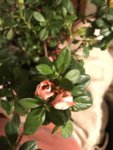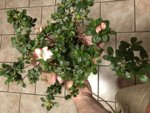substratum
Shohin
With Mothers Day recently passing, our local Publix grocery stores had many small, lovely, and absolutely bloom-covered azaleas, which I was told by the flower lady were Satsuki varieties. They had the variety pictured below (flower about 1.25" across), some with a scarlet double or regular flower, some with a salmon double or regular flower - all small leaf, 1-1.5" flower size. I've not been able to find any easy to navigate site to identify the variety - if anyone recognizes it, please let me know. I picked this one up yesterday on the clearance rack.
It looks like there may be as many as six plants in the pot. When it's finished blooming (still some buds on it that I'd like to see unfurled), I'm thinking about separating them to pot individually in an azalea mix, to let them recover and fatten up for a couple of years in pots in a sort of nursery area of my property. From a future bonsai specimen standpoint, is there a downside to doing that? Any tips? Related question - is this a futile pursuit on this particular plant?





It looks like there may be as many as six plants in the pot. When it's finished blooming (still some buds on it that I'd like to see unfurled), I'm thinking about separating them to pot individually in an azalea mix, to let them recover and fatten up for a couple of years in pots in a sort of nursery area of my property. From a future bonsai specimen standpoint, is there a downside to doing that? Any tips? Related question - is this a futile pursuit on this particular plant?






